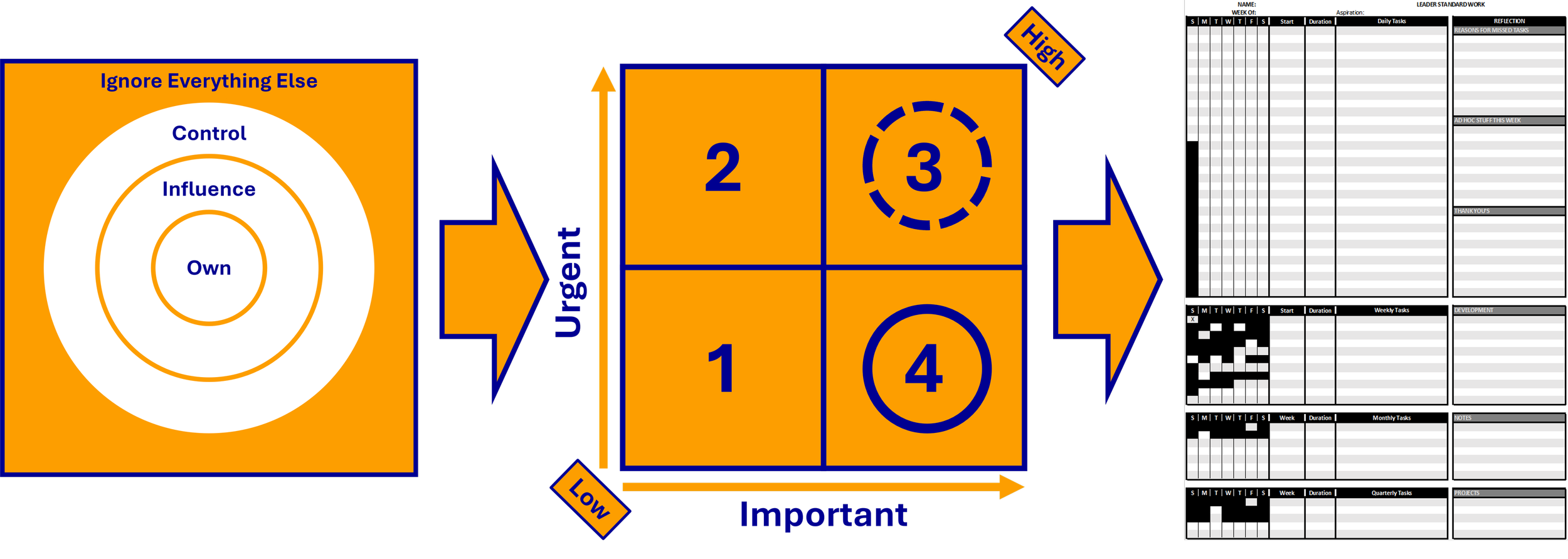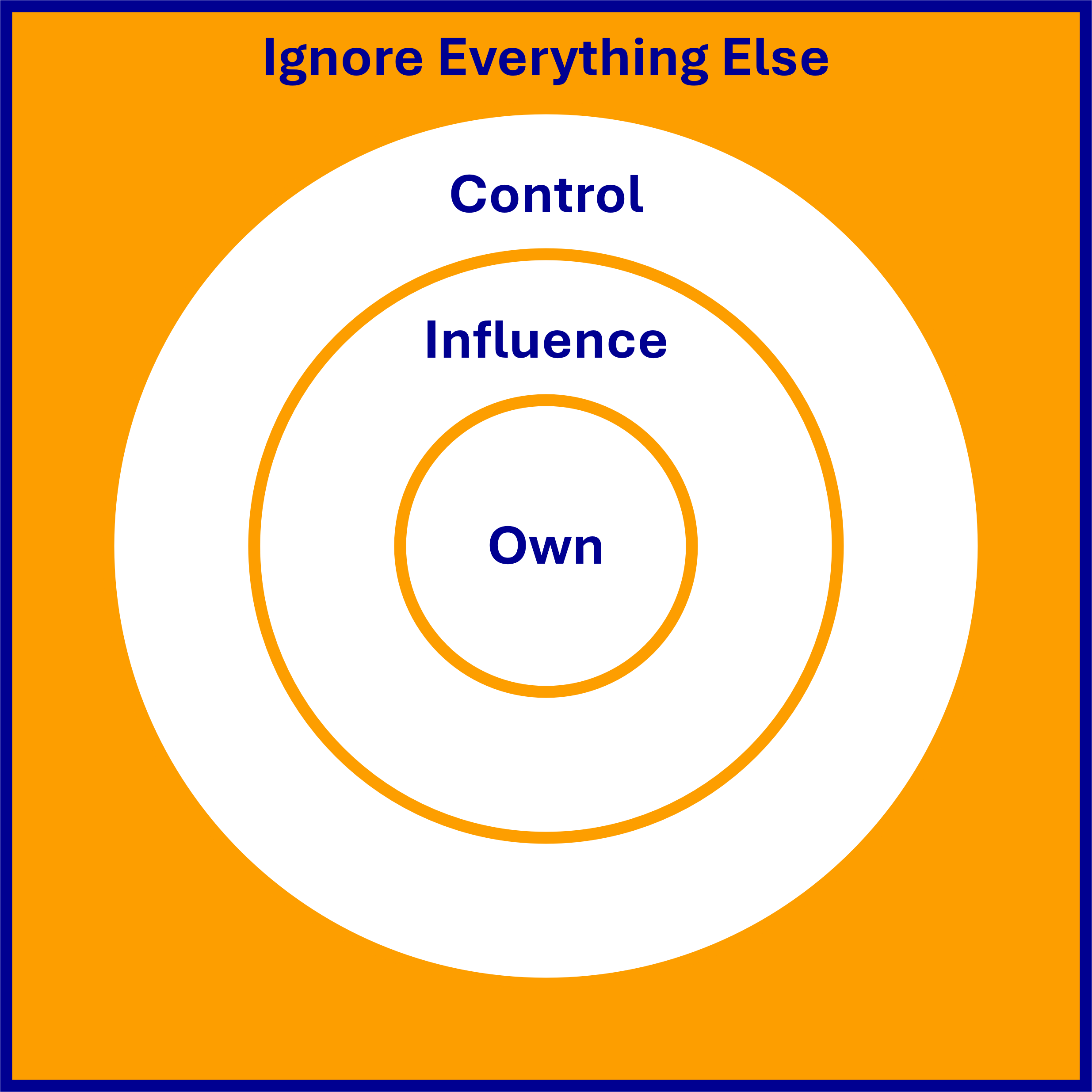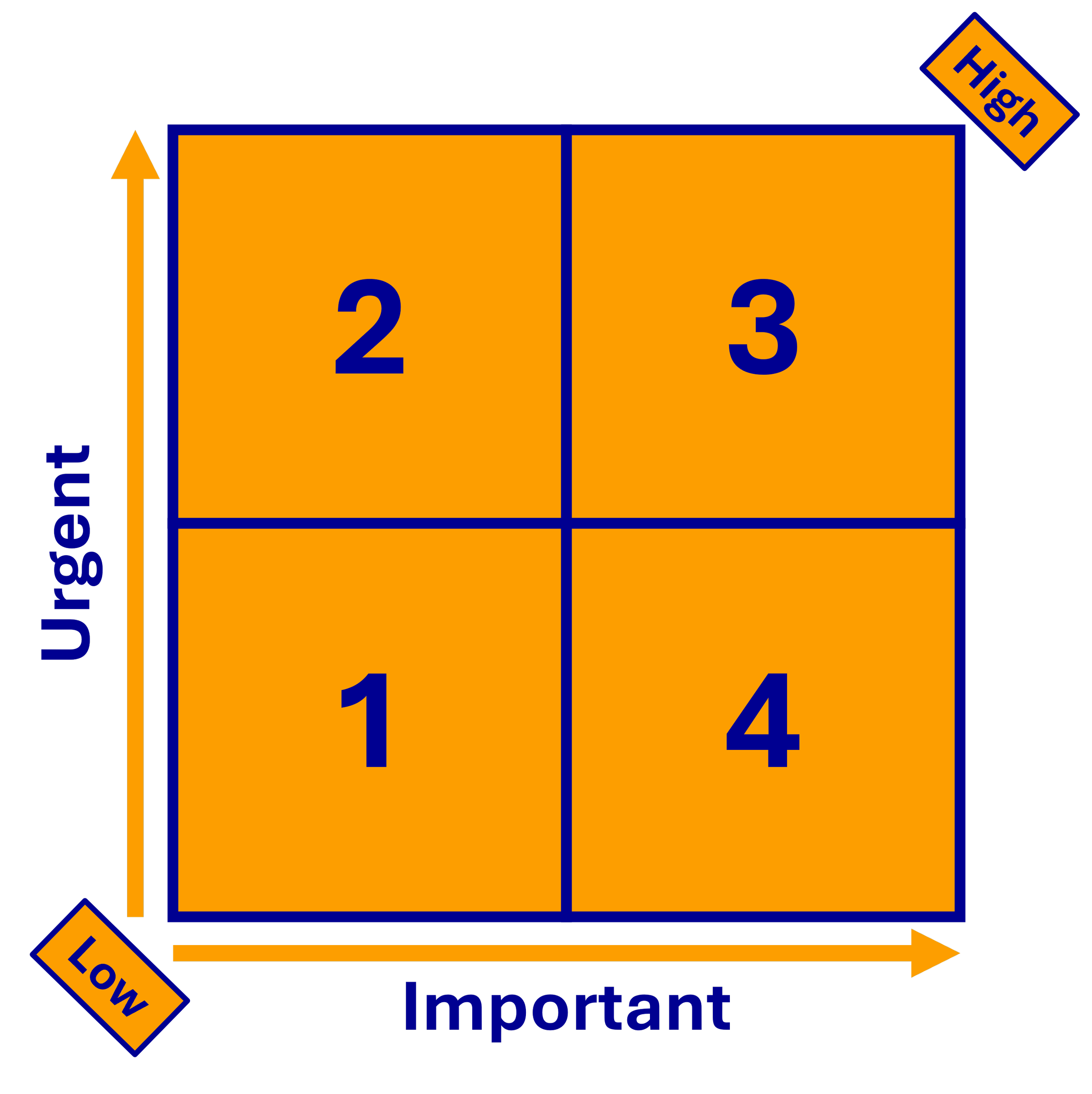Leader Standard Work Drives Productivity
Image Courtesy of Leg Up Solutions®
I recently received an email with respect to Leader Standard Work, which I will refer to as LSW, also known as Daily Standard Work.
There were a number of questions as to how prescriptive it should be, how aligned across the enterprise it should be, what the frequency and cadence should be, and many others. Within the organization of the email sender, there seemed to be a certain level of contention as to what should be the case with LSW. My response provided some overall insight and guidelines to consider when one creates their own LSW.
Since it is on my mind, I will share my response with you, in the following fashion: Organizational Strategy, The Prayer of Serenity, Quadrant Four and then LSW.
Organizational Strategy
LSW is most effective when it aligns with the overall strategy of the organization. Strategy is most effective when it, a) cascades from executives, to managers, and ultimately to team members, and b) when those at each level of the organization feel a keen sense of ownership for their piece of the strategy. This is not to say that LSW won’t work if the strategy is not clear and well understood, with ownership of it. Rather, LSW is not as effective. So, whether the strategy is clear or not, there are productivity gains that can come from LSW. The next three sections of this article will help explain why that is the case. But please understand that to optimize the value of LSW, strategy must be clear at each level and at those levels there needs to be a feeling of ownership for the strategy.
The Prayer of Serenity
I love the simplicity and wisdom of the prayer of serenity:
Grant me the serenity to accept the things I cannot change, the courage to change the things I can, and the wisdom to know the difference.
When LSW comes up in workshops our business produces and facilitates, we get into a discussion of a concept I learned while working in big food: Ownership, Influence, and Control.
1. Ownership
Do I actually own the problem, process or situation? Has it been formally assigned to me to manage, for better or for worse? If I don’t own it, then my ability to change the problem or process is limited, which takes us to the next step.
I work with the General Manager (GM) of a production facility. He has been assigned the ownership of results for that operation. This ownership comes from his position granted him from within the larger organization. As GM, he owns the results of that plant which are reflected by Earnings Before Interest, Depreciation, Taxes and Amortization or EBITDA. Because of this ownership, it is he who is ultimately accountable for the EBITDA Key Performance Indicator (KPI).
2. Influence
Can I influence a positive change to the problem, process, or situation?
Reporting through to the GM of that same organization is the Continuous Improvement (CI) Manager. At the time of the example, she was an individual contributor with no direct reports. The very nature of her role was to influence the organization with respect to Continuous Improvement. Yet, the organization, particularly the team members – mostly non-exempt operators – were jaded on CI efforts and viewed them as flavor-of-the-month. (Sound familiar?)
Through coaching sessions, we provided her, she was able to learn that CI was something that required experimentation and operational discipline, which if done correctly, would drive commitment to the CI process. She had one particular team member, who was an influencer himself. A powerful influencer, that did not see the benefit of CI, and was one of the most vocal about flavor-of-the-month. By being respectful and persistent, understanding she was now in a long game, she found an opportunity to influence this naysayer, who, also over time, became a proponent of what the production facility was striving to accomplish.
Influence is powerful. It does not take a lot of time for negative influence to sway opinion. Just take a look at social media. But to influence for the better requires the desire, commitment, and discipline to see it through to a productive end.
3. Control
There is an interesting relationship between control and ownership, and I am not the greatest fan of control as it usually requires enforcement driving a culture of compliance rather than a culture of commitment. A parent can control the behaviors of a child. A dictator controls. A principal in a school, or even teachers can control. Control generally has a negative connotation.
But the owner of a small business can dictate control over the strategy of the business. Parents can dictate control for the safety of their children, until their children are of the physical and mental maturity that they can see to their own safety. As a facilitator of workshops, I control the preparation, set up of the room and other aspects of each workshop, to ensure the participants have an optimal learning experience.
So, when we think of control, we tend to think of it in a bad way. But control can be positive as well. And when we understand it in a positive sense, we can think of what we can control to change the problem, process, or situation.
4. Everything Else
If I don’t Own, Influence or Control any aspect of the problem, process, or situation, then I eliminate it from my efforts and focus on what I do Own, Influence or Control. Just ignore it but be aware of it.
The concept of Ownership, Influence and Control can be characterized by the image below.
Image Courtesy of Leg Up Solutions®
Quadrant Four
Quadrant four is the sweet spot for high performance and productivity. It is in this quadrant of the 2x2 Urgency / Importance matrix where those things that have a big impact reside. They are not urgent, but very important. LSW typically falls in this quadrant, unless it is mandated by the organization or a supervisor, in which case, it is both urgent and important.
For better understanding, let’s take a peek at the 2x2 matrix and review it.
Image Courtesy of Leg Up Solutions®
1. Not Urgent, Not Important
These are typically activities that are either designated as time wasters or mindless activities we engage in to reset ourselves and include things such as water cooler conversations, video games, social media, casual reading, etc.
2. Urgent, Not Important
These are typically characterized as interruptions, phone calls, some types of firefighting, and ad hoc meetings – although I would argue that most meetings can be pared down significantly, if an hour, can we do it in 30 minutes, if 30 minutes can we do it in 15 minutes, if 15 minutes can we do it in a brief 1:1 conversation, If a brief 1:1 conversation, can we do it on a brief call? (I try not to descend to email, IM or text unless I must). Usually, things that demand our immediate attention, but which do not produce any meaningful results.
3. Urgent and Important
These items are where we spend most of our day engaged, are directly accountable for and demand immediate attention such as fire fighting to keep the line running, root cause analysis, meetings such as team meetings, Sales & Operations Planning (S&OP) meetings, Monthly Metrics Reviews, Quarterly Business Reviews, Annual Planning Meetings, etc.
4. Not Urgent, Important
This is the sweet spot. Activities such as gemba walks, CI activities and projects, personal development, coaching and developing others, meaningful reading, LSW, etc. Spending as much time here as you can, will give you the greatest leverage on your ability to get things done.
Leader Standard Work
Now that we understand Quadrant 4 (Q4) and its power, we can build LSW which is usually a combination of Quadrent Three (Q3) and Q4 activities. However, should you designate anything Q4, and you are truly serious about it, you will want it on your LSW. An example of LSW is shown below.
Image Courtesy of Leg Up Solutions®
You will note that I have some things blocked off to drive the right cadence and frequency. This is the template I currently use, which was created in a spreadsheet. LSW is easy to create in MS Excel or Google Docs. It’s a bit more cumbersome in a word processor or presentation platform. You need to choose what works best for you. Don’t try to get it perfect the first time. I’ve found that people who do get frustrated and quit using it. Experiment with it. Try different things and improve on them.
I worked for a Senior Director, that actually did his LSW in a word processor and printed it out. It had his daily, weekly, monthly, and quarterly standard work on that simple piece of paper, in landscape format, and he lived by it religiously. That’s what worked for him.
I never criticized it. Rather I learned from it to find what works best for me. What worked best for me years ago is not what works best for me today. It’s part of each of our own personal journeys of excellence. If we have the privilege to work for an organization that embraces the idea of LSW, then it helps the organization’s journey of excellence as well.
In summary, we need to understand what we own, influence and / or control, ignoring (but watching) the rest. From that we can find what fits in Q4 and then we can build our LSW. This is shown in the process flow below.
Image Courtesy of Leg Up Solutions®
Finally, if you would like to access the template for LSW above and modify it for yourself, you can find a copy HERE.
I very much appreciate you and the time you have taken to read this article. You can find more articles like this from me at https://www.legup.solutions/blog.
If you have thoughts this or other topics regarding yours or your organization’s journey of excellence, feel free to continue the conversation on my Secret Sauce slack feed.
Originally published at https://www.legup.solutions on 16 APR 2024






